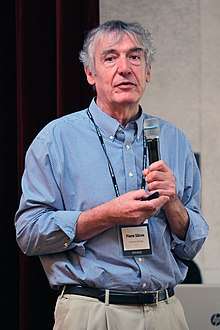Pierre Sikivie
Pierre Sikivie (born 29 October 1949) is an American theoretical physicist and currently the Distinguished Professor of Physics at University of Florida in Gainesville, Florida.[1] He invented the axion haloscope[2][3] and the axion helioscope[4] and has played an important role in the development of axion cosmology.[5][6]
Pierre Sikivie | |
|---|---|
 | |
| Born | October 29, 1949 (age 70) |
| Nationality | United States |
| Alma mater | Yale University |
| Known for | Axion Cosmology, Axion Dark Matter Experiments |
| Scientific career | |
| Fields | Physics |
| Institutions | University of Florida |
| Thesis | Lepton and Hadron Spectra in Universal Gauge Theories (1975) |
| Doctoral advisor | Feza Gürsey |
Academic career
Sikivie completed his Licencie en Sciences from University of Liege, Belgium in 1970 and completed his Ph.D. in Physics under Feza Gürsey from Yale University in 1975 with thesis Lepton and Hadron Spectra in Universal Gauge Theories. He was a Research Associate at Dept. of Phys., Univ. of Maryland from 1975 to 1977 and at SLAC from 1977 to 1979. He became Senior Fellow at CERN from 1979 to 1981 and Assistant Professor at University of Florida from 1981 to 1984. He became an Associate Professor of Physics at University of Florida in 1984, and promoted to Professor in 1988. He received his present title of "Distinguished Professor" in 2012. He is the 2020 recipient of the Sakurai Prize.
In 1994 Sikivie was elected a Fellow of the American Physical Society. He was a Guggenheim Fellow for the academic year 1997–1998.[7]
Dark matter axion physics
Sikivie played a crucial role in the development of the Axion Dark Matter eXperiment (ADMX). In 1983, Sikivie, along with J. Preskill, M. B. Wise, F. Wilczek, L. F. Abbott, M. Dine, and W. Fischler, discovered that cosmic axions created from mis-alignment mechanism can be a substantial fraction of Dark Matter. Later Sikivie laid the theoretical ground for dark matter axion detections such as the ADMX.
References
- "Pierre Sikivie at University of Florida".
- Graham P. Collins (2006). "An experiment may have seen an elusive new particle". Scientific American.
- Rachel Courtland (2014). "The Hunt for the Invisible Axion". IEEE.
- Konstantin Zioutas (2006). "Let there be axions". CERN.
- Van Bibber, Karl; Tanner, David B.; Van Bibber, Karl A. (2010). "Pierre Sikivie and the Gift for Simple Ideas". American Institute of Physics Conference Series. AIP Conference Proceedings. 1274 (1): 1–6. Bibcode:2010AIPC.1274....1V. doi:10.1063/1.3489552. hdl:10945/60986. OSTI 21426567.
- Jon Cartwright (2012). "Axions could solve lithium problem". Physics World.
- Pierre Sikivie, John Simon Guggenheim Memorial Foundation